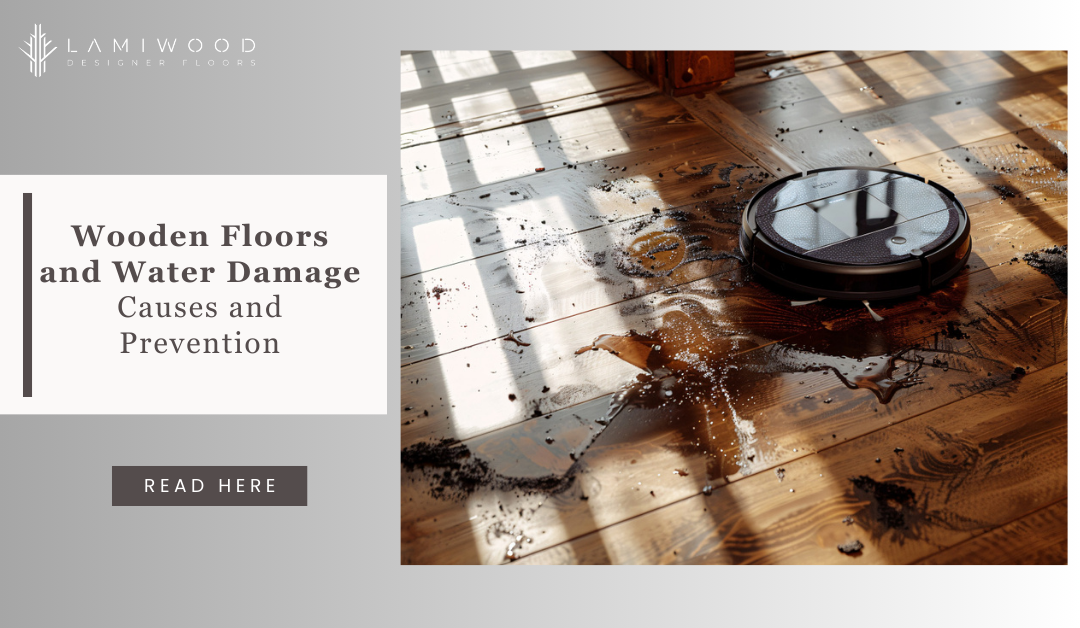Wooden flooring adds warmth, elegance, and a touch of nature to any space. However, wooden flooring is susceptible to water damage despite its aesthetic appeal, which can compromise its structural integrity and aesthetic charm. Let’s delve into the causes, types, prevention, and remediation of water damage to wooden flooring, equipping you with the knowledge to safeguard your investment and preserve the beauty of your floors.
Causes of Wooden Flooring Water Damage
- Excessive Moisture Exposure: Prolonged exposure to moisture from leaks, spills, or high humidity levels can seep into the wood, causing it to swell, warp, or cup.
- Plumbing Leaks: Undetected plumbing leaks beneath or near wooden flooring can lead to water intrusion, resulting in gradual damage over time.
- Flooding: Natural disasters or indoor flooding incidents can inundate wooden flooring with water, causing severe damage if not addressed promptly.
- Poor Installation: Improper installation techniques or inadequate sealing around the edges can leave gaps for water to penetrate, leading to water damage over time.
Types of Wooden Flooring Water Damage
- Swelling: When water penetrates the wood fibers, it causes them to swell, resulting in visible bulging or uneven surfaces.
- Warping: Excessive moisture can cause wooden planks to warp or bow, altering their shape and compromising the floor’s flatness.
- Cupping: Cupping occurs when the edges of wooden planks become higher than the center, creating a concave shape. It is often caused by moisture imbalance between the top and bottom surfaces of the planks.
- Mold and Mildew Growth: Damp conditions resulting from water damage provide an ideal environment for mold and mildew to thrive, posing health risks and further damaging the wooden flooring.
How to Prevent Wooden Flooring Water Damage
- Maintain Proper Indoor Humidity: Keep indoor humidity levels between 30% to 50% to prevent excessive moisture buildup that can damage wooden flooring.
- Promptly Address Spills and Leaks: Clean up spills immediately and address plumbing leaks promptly to prevent water from seeping into the flooring.
- Use Area Rugs and Mats: Place area rugs or mats in high-traffic areas and near entryways to absorb moisture and protect the wooden flooring from wear and tear.
- Regular Inspection: Conduct regular flooring inspections for signs of water damage, such as discoloration, warping, or unusual odors, and address any issues promptly.
Remediation Techniques for Water-Damaged Wooden Flooring
- Dry Out the Area: Use fans, dehumidifiers, and moisture meters to dry out the affected area thoroughly. Ensure proper ventilation to expedite the drying process.
- Sand and Refinish: For minor water damage, sanding and refinishing the affected area can restore the appearance of the flooring and smooth out any imperfections.
- Replace Damaged Planks: Severely damaged planks may need to be replaced. Carefully remove the affected planks and install new ones, ensuring a seamless transition.
- Address Mold and Mildew: If mold or mildew is present, use a mixture of water and mild detergent to clean the affected area. For severe mold infestations, consult a professional remediation service.
When to Completely Replace Water-Damaged Wooden Flooring:
Severe Structural Damage: If the wooden flooring has experienced extensive swelling, warping, or cupping, it may be beyond repair and require replacement.
Persistent Mold Growth: If mold growth persists despite remediation efforts, it may indicate deeper structural damage or moisture issues that necessitate replacement.
Safety Concerns: If the water damage compromises the structural integrity of the flooring or poses safety hazards such as tripping hazards, replacement may be necessary.
Conclusion:
Water damage poses a significant threat to the beauty and longevity of wooden flooring. By understanding the causes, types, prevention measures, and remediation techniques outlined in this guide, you can effectively protect your investment and preserve the natural charm of your wooden floors. Remember, prompt action is crucial in mitigating water damage and preventing further deterioration. If in doubt, consult a professional flooring specialist for expert advice and assistance. With proper care and maintenance, your wooden flooring can continue to exude timeless elegance for years to come.

